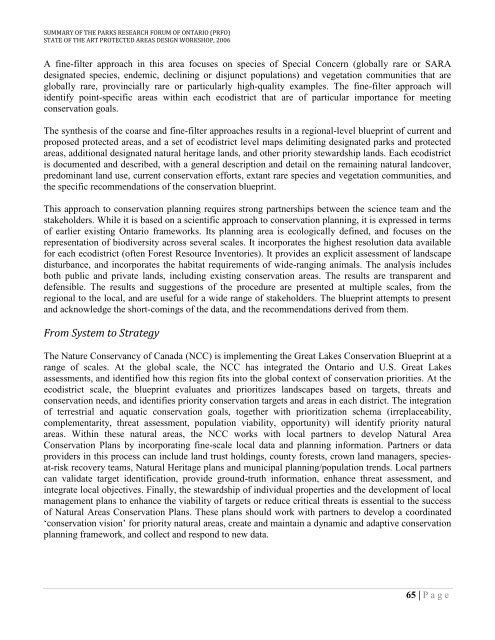Top-Down vs. Bottom Up: Working Towards Consensus ... - CASIOPA
Top-Down vs. Bottom Up: Working Towards Consensus ... - CASIOPA
Top-Down vs. Bottom Up: Working Towards Consensus ... - CASIOPA
- No tags were found...
Create successful ePaper yourself
Turn your PDF publications into a flip-book with our unique Google optimized e-Paper software.
SUMMARY OF THE PARKS RESEARCH FORUM OF ONTARIO (PRFO)STATE OF THE ART PROTECTED AREAS DESIGN WORKSHOP, 2006A fine-filter approach in this area focuses on species of Special Concern (globally rare or SARAdesignated species, endemic, declining or disjunct populations) and vegetation communities that areglobally rare, provincially rare or particularly high-quality examples. The fine-filter approach willidentify point-specific areas within each ecodistrict that are of particular importance for meetingconservation goals.The synthesis of the coarse and fine-filter approaches results in a regional-level blueprint of current andproposed protected areas, and a set of ecodistrict level maps delimiting designated parks and protectedareas, additional designated natural heritage lands, and other priority stewardship lands. Each ecodistrictis documented and described, with a general description and detail on the remaining natural landcover,predominant land use, current conservation efforts, extant rare species and vegetation communities, andthe specific recommendations of the conservation blueprint.This approach to conservation planning requires strong partnerships between the science team and thestakeholders. While it is based on a scientific approach to conservation planning, it is expressed in termsof earlier existing Ontario frameworks. Its planning area is ecologically defined, and focuses on therepresentation of biodiversity across several scales. It incorporates the highest resolution data availablefor each ecodistrict (often Forest Resource Inventories). It provides an explicit assessment of landscapedisturbance, and incorporates the habitat requirements of wide-ranging animals. The analysis includesboth public and private lands, including existing conservation areas. The results are transparent anddefensible. The results and suggestions of the procedure are presented at multiple scales, from theregional to the local, and are useful for a wide range of stakeholders. The blueprint attempts to presentand acknowledge the short-comings of the data, and the recommendations derived from them.From System to StrategyThe Nature Conservancy of Canada (NCC) is implementing the Great Lakes Conservation Blueprint at arange of scales. At the global scale, the NCC has integrated the Ontario and U.S. Great Lakesassessments, and identified how this region fits into the global context of conservation priorities. At theecodistrict scale, the blueprint evaluates and prioritizes landscapes based on targets, threats andconservation needs, and identifies priority conservation targets and areas in each district. The integrationof terrestrial and aquatic conservation goals, together with prioritization schema (irreplaceability,complementarity, threat assessment, population viability, opportunity) will identify priority naturalareas. Within these natural areas, the NCC works with local partners to develop Natural AreaConservation Plans by incorporating fine-scale local data and planning information. Partners or dataproviders in this process can include land trust holdings, county forests, crown land managers, speciesat-riskrecovery teams, Natural Heritage plans and municipal planning/population trends. Local partnerscan validate target identification, provide ground-truth information, enhance threat assessment, andintegrate local objectives. Finally, the stewardship of individual properties and the development of localmanagement plans to enhance the viability of targets or reduce critical threats is essential to the successof Natural Areas Conservation Plans. These plans should work with partners to develop a coordinated„conservation vision‟ for priority natural areas, create and maintain a dynamic and adaptive conservationplanning framework, and collect and respond to new data.65 | P a g e


